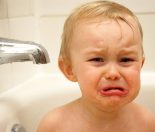This asthma article discusses the main signs and symptoms of asthma and guidelines with which parents can help asthmatic children.
What is Asthma?
Asthma is a common disorder of the respiratory system that causes recurring attacks of breathlessness, wheezing and cough. The breathlessness is due to narrowing (constriction) of large and small airways, making it harder for air to move through to the lungs.
The narrowing of the airways (bronchi) is due to:
- Spasm of the bronchial muscle that makes up the airways
- Excessive production of mucus
The cause of asthma is not known, but both genetic and environmental factors can result in the respiratory system being hypersensitive. When the child is exposed to certain triggers, a reaction will occur in the airways and lungs (spasm, mucus production and inflammation) known as an asthma attack.
Triggers can include infections, house dust, mites or pollen, emotional upsets, smoking, exercise, cold air or weather changes, and chemical irritants.
Asthma in children is usually associated with external factors (pollen, smoke, dust etc).
Asthma in a baby or infant is usually associated with a food allergy.
Asthma affects many schoolchildren, with the average age of onset being between 3-8 years. In childhood it is twice as common in boys, than in girls.
What are the signs and symptoms of asthma?
Asthma in children usually presents as a cough (particularly at night time), wheezing and shortness of breath.
It can be mild in some children, hardly requiring any treatment. Other children can have severe asthma, requiring regular treatment and even hospitalisation.
Asthma is usually diagnosed by your GP, who will ask about the child’s symptoms and a history of what has happened to your child.
In children over five years a useful test is the peak flow metre, which measures how fast air can be pushed out of the lungs.
Asthma is often associated with other allergic conditions, such as eczema.
What is the treatment for asthma?
The most common treatment is inhaler medication which the child breaths straight into their lungs:
- Relievers (bronchodilators) which open the airways. These are taken when the child feels an asthma attack coming on and therefore should go everywhere with the child.
- Preventers (eg. steroids) which prevent an attack and are taken regularly.
These may be prescribed by your GP.
Younger children will need to use a spacer device, which allows them to receive the medication over several breaths. This is available from your pharmacy.
Risks & complications of asthmatic attacks

In the event of a severe attack, where the child cannot breathe:
- Call 111 and stay with your child
- Sit the child upright and help them to take 2 puffs of their ‘reliever’ inhaler, using the spacer
- Repeat the inhaler every 5 minutes, until the ambulance arrives or the child recovers.
What can I do for my child with asthma?
Some GP surgeries have asthma clinics run by practice nurses. It may be worth enquiring about these – they will give you tips on identifying your child’s triggers, possibly asking you to keep a diary so that you can pin-point what is setting off your child’s asthma – remember there may be more than one trigger.
Many families have a child asthma plan, which reminds them who to call and what medications to give, in the event of a severe asthma attack.
Night-time coughing can be helped by propping your child upright and offering sips of water or cough syrup. Some families find that a steam device is useful; alternatively take the child into the bathroom while you run a hot bath – the steam may ease the cough.
It is important to be calm and you can try distracting your child with a story or song, to break the habit of the persistent cough.
It is essential to avoid cigarette smoke, especially in the house or car.
In the long term, exercise and improved posture can be beneficial in strengthening the respiratory muscles and developing better breathing patterns.
There is also advice available to manage asthma without medication, for example:
- the Alexander technique – in which you re-learn simple body movements and postures to achieve improved balance and coordination, improved breathing and increased energy levels.
- the Buteyko technique – teaches you improved breathing techniques, which help you control your breathing rate and may reduce your need for medications.
Helpful Asthma Websites and Articles
Website of Asthma New Zealand – The Lung Association (Inc) and it’s 9 regional affiliate societies.
www.asthmanz.co.nz or www.asthmafoundation.org.nz
Website of Asthma and Respiratory Foundation of New Zealand (Inc.) and it’s 17 regional affiliate societies, plus the numerous COPD Support Groups.
http://www.alexandertechnique.com/
Click on the web link for more information on the Alexander technique
For more information on related conditions see our article on Eczema
For information on how parents can help visit our article Common Allergies







